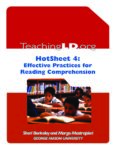Effective Practices for Reading Comprehension
The ability to read and comprehend text is crucial to achieving success, not only in school but in the working world. Good readers are purposeful when reading and choose appropriate comprehension strategies automatically; however, less skilled readers, including many students with disabilities, often do not. These students need explicit instruction in order to accurately and efficiently gain meaning from text. This HotSheet will define reading comprehension and describe some of the more and less effective practices for instruction.
What is Reading Comprehension?
Comprehension is the ultimate goal of reading. Understanding and obtaining meaning from written text material is what is commonly referred to as comprehension. Reading comprehension is interdependent on students’ existing background knowledge, knowledge about the content of the text, awareness of cognitive and metacognitive strategies (strategies that help students to be more aware of their own thinking and learning), and competencies in basic reading skills including accurate and fluent decoding and vocabulary knowledge. Reading comprehension is often demonstrated through students’ abilities to retell the information in their own words or to answer correctly questions about what was read.
Why is Reading Comprehension Important?
Teaching children to read, including reading comprehension, is one of the major purposes of schools. Students’ success in school is largely determined by their ability to read fluently and gain meaning from reading materials in all subject areas. Younger children (primary aged) can learn strategies to assist with comprehending the meaning of pictures and the basic story elements of narrative text read aloud to them. Older students can learn more complex strategies to help with their understanding of the expository text found in their science and history textbooks. Students can also learn to self-regulate their own reading comprehension. Self-regulation is the ability to monitor one’s own learning. This becomes increasingly important as students progress through the grades and are expected to “read to learn.” However, the ability to read and understand does not end with the classroom; reading comprehension is of lifelong importance. Students apply reading comprehension skills to everyday life. For example, reading comprehension is necessary for a person to successfully conduct research on-line, correspond through email, follow a recipe or a computer manual, and even obey road signs.
Reading Comprehension Facts
- A student can read fluently and not understand what was read.
- Reading comprehension is an active process.
- Strategies for improving reading comprehension can be taught.
- Basic reading skills, including decoding and fluency, can influence text comprehension.
- Vocabulary knowledge influences text comprehension.
- Background knowledge influences text comprehension.
- Expository text, such as content area instruction materials, may require more complex reading comprehension strategies than those required for narrative texts, such as prose stories. See table on next page.
Reading Comprehension
 View PDF: "Reading Comprehension"
View PDF: "Reading Comprehension" Sheri Berkeley and Margo Mastropieri describe the importance of reading comprehension and what is known about effective practices.